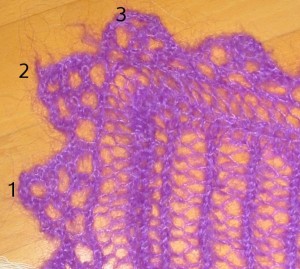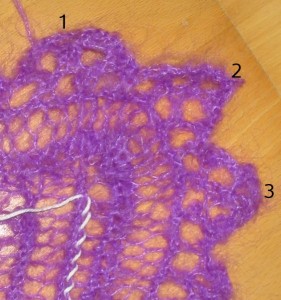A Question of Lace
Wir unterbrechen die „Themenaufholjagd“ für eine aktuelle Frage… ich weiß, ich habe meine Socken noch nicht mal alle vorgezeigt, aber wie ich schon schrieb (glaube ich), meine Sockenwolle ist verstrickt und seit drei oder vier Wochen sitze ich an meinem erste Lace-Schal aus „Victorian Lace Today„. Einige Bahnverspätungen, ein paar Stunden im Wartezimmer… und auch die Randbordüre ist schon fast angestrickt. Damit allerdings habe ich ein Problem.
I know, I promised a lot of other posts which I have not done yet, but that’s an emergency… I haven’t shown all my socks yet but (I think) I wrote that I’ve used all my sockyarn and can therefor knit other things. For the last three or four weeks I have been knitting on my first lace scarf/ shawl from „Victorian Lace Today„. Some waiting for trains and in a medical practice later I am nearly finished and my knit on border also is nearly done. But that’s where the problem starts.
Die Anleitung gibt nur recht lapidar an, daß man zuerst „Corner A“, also „Ecke A“ stricken soll. Es ist auch ausführlich beschrieben, in welche (Rand)Maschen man beim Anstricken mehrfach strickt. Die Ecke geht über drei Rapporte des Bordürenmusters.
1.Rapport: 4 x einfache Verbindung (also eine Bordürenreihe in einer Masche verankern), 2 x doppelte Verbindung (zwei Bordürenreihen in einer Masche verankern)
2. Rapport: 1x doppelte Verbindung, 1x dreifache Verbindung (bis hierhin alles an den langen Rand des Schals) 1x doppelte Verbindung (ab hier jenseits der Ecke in die kurze Reihe des Schals gestrickt)
3. Rapport: 1x doppelte Verbindung, 5 x einfache Verbindung
Klingt gut und einfach.. ist aber für einen Rapport von 14 Reihen. Meine Randbordüre hat nur 12. 🙁
The instructions tell simply to knit „Corner A“. There are also charted instructions towards the end of the book how to distribute the joints, this uses three repeats of the border patter:
1. repeat: 4 single joints, 2 double joints
2.repeat: 1 double joint, 1 triple joint (up to here on the long side of the scarf), 1 double joint (the first knitted on the other side of the edge in the short side of the scarf)
3. repeat: 1 double joint, 5 single joints
Sounds precise and easy. Only it’s for a pattern with 14 rows, my pattern only has 12…
 Ich habe es mit folgender Reihenfolge versucht:
Ich habe es mit folgender Reihenfolge versucht:
Rapport 1: 2 einfache Verbindungen, 2 doppelte Verbindungen
Rapport 2: 3 doppelte Verbindungen
Rapport 3: 1 doppelte Verbindung, 4 einfache Verbindungen
So this us what I tried for Corner A:
Repeat 1:2 single joints, 2 douple joints,
Repeat 2: 3 double joints
Repeat 3: 1 double joint, 4 single joints.
Der Rand außen liegt so auch recht flach, aber (auf dem Bild sieht man das nicht so gut) da wo der Rand an den Schal angestrickt ist bildet sich eine hochstehende Blase.
The outer edge of the border seams to be laying nicely flat, but where it is knitted on (it’s not well to see on the picture) there is a „bubble“, it does not lay flat at all.
Noch lustiger wird es dann bei der „Ecke B“. Hierfür gibt es gar keine Anleitung. Die Mehrfachverbindungen sind ja nicht symmetrisch auf beide Seiten verteilt, soll die Ecke B eher „gespiegel“ gestrickt werden, also wieder die meisten Maschen in die lange Seite, oder einfach wieder genauso, weil es egal ist, wie sich das um die Ecke verteilt?
Ich habe es so gemacht (etwas auch bedingt durch die Maschenzahl die noch übrig war):
Rapport 1: 1 einfache Verbindung, eine doppelte Verbindung, eine dreifache Verbindung.
Rapport 2: 3 doppelte Verbindungen, wobei ich ab der zweiten davon wieder in der langen Schalseite gearbeitet habe
Rapport 3: 1 doppelte Verbindung, 4 einfache Verbindungen
Das Problem ist das gleiche, eine hochstehende Blase. 🙁
„Corner B“ is even more fun, because there is no explanation at all. The joints are not symmetrical distributed to the long and the short side of the scarf, so how is „Corner B“ supposed to be done? Mirrored? Or not because it just doen’t make a difference?
What I did (also due to the number of stitches that remained in my short side) is:
Repeat 1: 1 single joint, 1 double joint, 1 triple joint
Repeat 2: 3 double joints (with the 2nd double joint on the long side of the scarf)
Repeat 3: 1 double joint, 4 single joints
Same problem: ugly „bubble“ 🙁
Nun, für diesen Schal ist es egal. Das Garn („kid light“ von Schachenmayr) war eine liebe Spende und lila steht mir nicht wirklich, ich hatte also eh nie vor, ihn zu tragen. (Und weiß jemanden, der das trotz der Fehler die drin sind gerne tun wird.) Gespannt habe ich noch nicht (es fehlen auch noch zwei Ecken), aber das Garn besteht zu 30% aus Mohair, der Rest sind diverse Polyfasern, da wird spannen nicht viel ändern.
Aber.. für mein nächstes Werk warten hier schon vier appetitliche Knäuel Rowan kidsilk haze von Daniela und die möchte ich nur sehr ungern versauen… :/
Deswegen, bitte, bitte, falls jemand hier mitliest, der schon mal so einen Schal gestrickt hat, vielleicht sogar aus dem Buch (und der Schal ist als „einfach“ ausgewiesen…) oder generell Erfahrung mit solchen angestrickten Rändern hat… bitte sagt mir, was ich entweder anders machen muß oder ob sich das mit kidsilk haze beim Spannen grade zieht?
Hilfe!
Well for this scarf I don’t mind. The yarn („kid light“ from Schachenmayr) was a kind gift and the colour isn’t right for me, so I never intended to wear it. (And I know someone who will wear it because of the colour and will not mind the mistakes that I made.) I didn’t block it yet, because there are two more corners to go, but the yarn is only 30% mohair fibre, the rest is „chemical“, so blocking will probably not change a lot.
But for my next shawl I already bought some oh so soft and light Rowan kidsilk haze from Daniela and I do not want to mess that up!
So, please, please, if someone is reading here who has experience with knitted on borders or with knitting from that book (the scarf was btw marked „easy“ lace…) I beg you, tell me how I can make it better! Or will everything be allright, once it’s knit with kidsilk haze and blocked?
Help!

